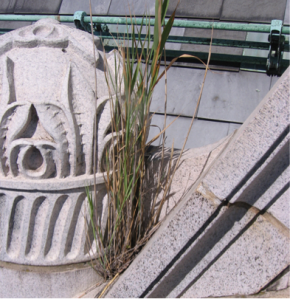Each week we’re bringing you an in-depth look at one of the standard conditions we encounter and document during inspections of buildings and civil structures.
Part 8: Biological Growth
Biological growth refers to the accumulation of living organisms on the surface of building materials. This can include fungi, algae, lichens, mosses, and vascular plants. The term biological colonization may be used to refer to microorganism and plant growth, as well as colonization by animals. The term biofilm is sometimes used to describe areas of microbial growth.
Biological growth can occur on all building materials where moisture can accumulate and linger. When investigating wood building components, we distinguish between fungi (including molds and mildews), lower plants (non-vascular), and higher plants (vascular).
Plants and fungi require water in order to survive. Thus, unwanted biological growth often occurs in sheltered areas that do not dry out quickly. Higher plant forms appear where poor drainage or surface features allow dirt and debris to build up. Some biological growth may be tolerated as simply a cosmetic nuisance, but other forms may cause or contribute to deterioration. For example, lichens secrete oxalic acid, which dissolves some types of stone, and the roots and tendrils of vascular plants have a mechanically-destructive effect on building materials.
Next in this series: Guano
Click here to see all posts in this series.
Click here for an index of all posts in this series, or download a pdf of the complete series.

